Growing Summer Squash Vertically
This post may contain affiliate links, which means that I may receive a commission if you make a purchase using these links. As an Amazon Associate I earn from qualifying purchases.
Summer squash are among the easiest and most productive plants to grow in the garden. They are fun to grow too since there are so many different shapes, colors, and varieties. Often times I find myself trying to squeeze in more varieties than I have room for in the garden.
Summer squash loves the summer heat, and usually begins producing within 60 days after planting and continues all season until frost, disease, or squash vine borer takes it out.
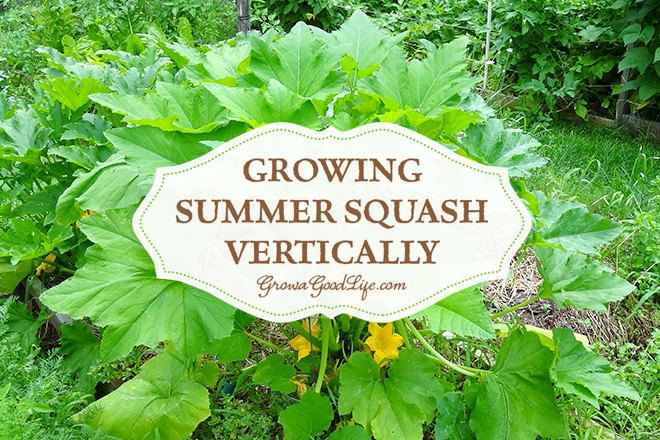
What is Summer Squash?
Squash is divided into two types, winter squash and summer squash. Summer squash differs from winter squash in that it is harvested young while it is still tender.
There are so many varieties of summer squash, including zucchini or courgette, patty pan or scallop, yellow crookneck, and yellow straight neck squash. Each type has many varieties, colors and shapes.

In contrast, winter squash has a thicker rind and is harvested in the fall, cured, stored, and consumed during the winter months. Common winter squash varieties include acorn, butternut, pumpkin, and spaghetti squash. Winter squash usually grows on long, rambling vines.
Most summer squash have a bushy growth habit. The fruit begins forming at the base of the stem and continues developing up the stalk as the plant grows. Even though summer squash plants are bush like, the stem of the plant does tend to lengthen a little as it grows.
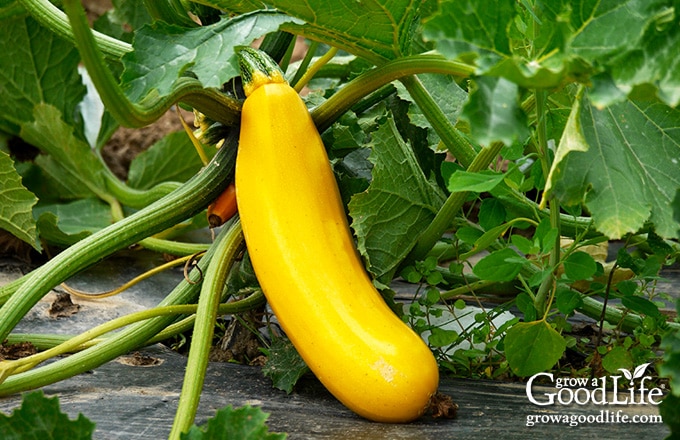
Since I have been converting my garden to permanent raised beds that are only 3-feet wide, I had to think of some creative ways to keep the summer squash confined to the bed and prevent it from flopping out into the aisles. For me, the logical answer was to grow summer squash vertically using tomato cages to support the plant and keep it upright.
Benefits of Growing Summer Squash and Zucchini Vertically
Although the reason I wanted to grow summer squash upright was to save space, I quickly discovered that growing summer squash and zucchini in tomato cages had other benefits as well.
- Growing summer squash vertically saves space. The plants can easily be trained to remain in the tomato cage as it grows. The cage provides support and keeps the plant upright, preventing it from flopping out of the growing bed into the walking paths.
- Growing zucchini upright encourages air movement. Good air circulation around the plant helps the foliage stay dry and averts downy mildew and other fungal diseases.
- Vertical growth keeps the squash off the ground. There is less chance of the fruit rotting from excess moisture since the squash is not touching the ground.
- It’s easier to see the zucchini to harvest. Growing upright allows the squash to be more visible reducing the chance of overgrowth. No more giant zucchinis!
- More light gets to the plant when growing upright. Zucchini and summer squash thrive in sun. Since the foliage is more spread out when growing upright, there is less shading allowing the plant to absorb more sunlight. Also, most pollinators prefer to forage in sun.
- Less places for squash bugs and other pests to hide. Squash bugs, cucumber beetles and other pests have less area to hide near the ground. Also, since the foliage is upright, it is easier to scout for and destroy eggs before they hatch.
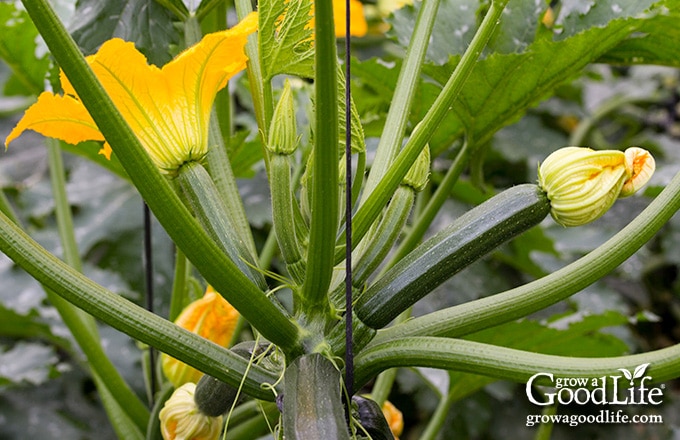
How to Grow Zucchini in Tomato Cage
Step 1: Plant the zucchini and summer squash. Either transplant seedlings or direct sow summer squash in a mound of soil.
Step 2: Add the tomato cage. Simply place a tomato cage securely in the ground when the zucchini and summer squash are young. Push the legs into the ground up to the first ring.
If you are using a flimsy tomato cage, hammer in a stake or long piece of rebar for extra support. Tie the tomato cage securely to the stake.
Step 3: Mulch the plants. Add organic mulch around the plants to help keep the weeds down, the roots cool, and conserve moisture. Keep the mulch a few inches away from the stem of the plant.
Step 4: Guide the zucchini and summer squash up. As the plant grows, gently direct the foliage and stem upward through the tomato cage. A few of the hollow stems do bend over the cage wires as the plant grows, but overall the benefits of growing summer squash vertically outweigh a few bent stems.
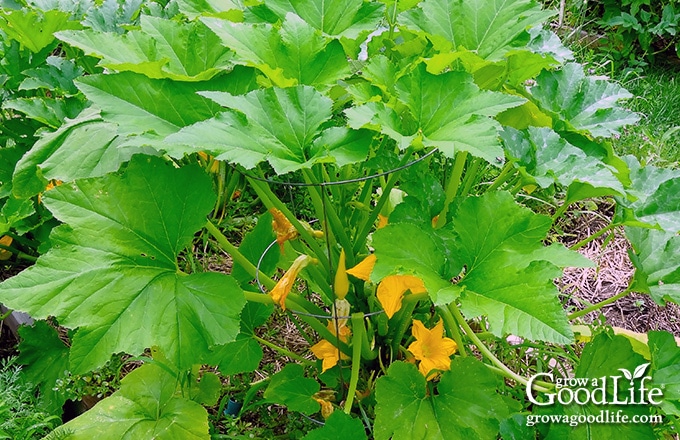
Growing summer squash vertically by trellising or in tomato cages helps to save space, encourages air circulation, and allows the squash to be more visible reducing the chance of overgrowth.
You May Also Like:
- 3 Easy Ways to Preserve Summer Squash
- Zucchini Garlic Bites Recipe
- DIY Self-Watering Containers
- How to Build a Square Food Garden
Good planning is key to a successful vegetable garden
Whether you are new to growing your own food or have been growing a vegetable garden for years, you will benefit from some planning each year. You will find everything you need to organize and plan your vegetable garden in my PDF eBook, Grow a Good Life Guide to Planning Your Vegetable Garden.
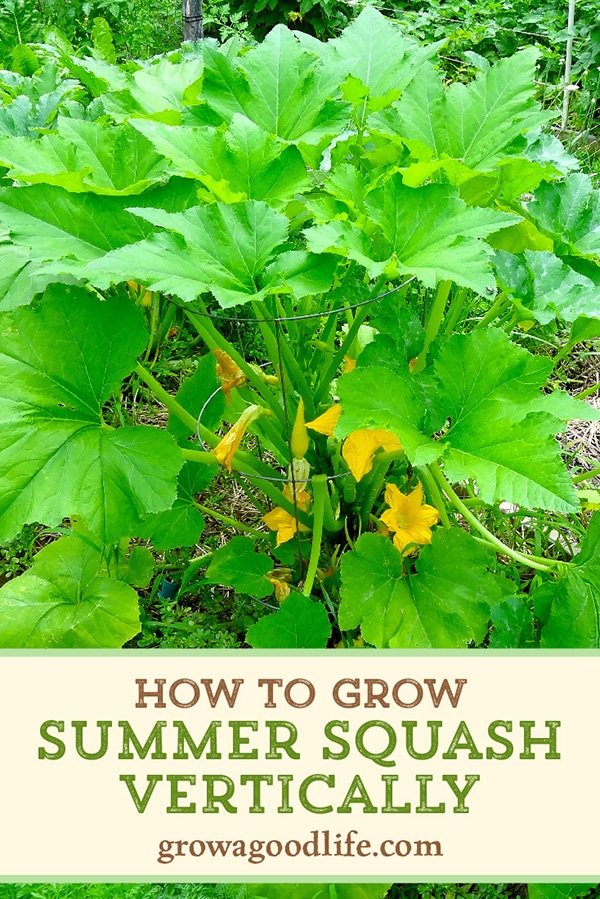


Thanks for this tip using tomato cages on the zucchini plants because I do have a space problem and will definitely give this a try. As with tomatoes, I usually drive a tall garden stake into the ground inside the tomato cage for additional support. Sometimes the tomato cages are not that sturdy with heavy growth hanging on them.
Definitely going to try this. My biggest problem raising summer squash are the squash bugs. They always seem to find me. Does growing them like this help in that area?
It won’t prevent squash bugs, but it may make it easier for you to find the eggs and pick them off, and to pick off the bugs. Look up Squash Bugs and Duct Tape. This year, I’m also going to try my Crème Brule torch to kill the squash bugs.
Thank you for sharing at Tuesdays with a Twist!!! You have been featured today at Back to the Basics. Looking forward to seeing what you share this week.
This is a great idea – You’re being featured tomorrow at Garden Up green on Tuesdays with a twist. Hope you stop by and share with your friends.
-Carole
I found out one of the drawbacks of vertical gardening this week end, as ex huricane Bertha blew over here in the UK, all my beans and winter squashes are now on the ground. I will have to find stronger supports for next year. I am now off to the garden to try to salvage what I can.
That’s a pretty neat trick! I bet it makes for easier picking too. Will try next year.
Interesting idea, I may give it a try. I am growing a tromboncino up a trellis because it naturally vines.
Great idea. It looks like it is easier to see where your squash is, that way you don’t end up with squashzilla! I had one last year that hid under some of those huge leaves and it ended up being almost 2 feet long by the time I found it! Thanks.
I would have never thought of that…I always have a ton of tomato cages laying around. I will have to try that next year! Thanks for sharing that tip with us!
What an interesting idea! Unfortunately, I have yet to figure out how to grow summer squash that takes up a lot of room. All of mine – save for one – are still fairly tiny, although they are producing a squash here and there.